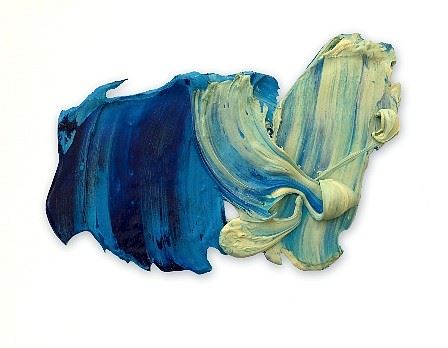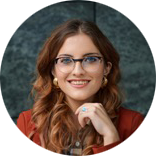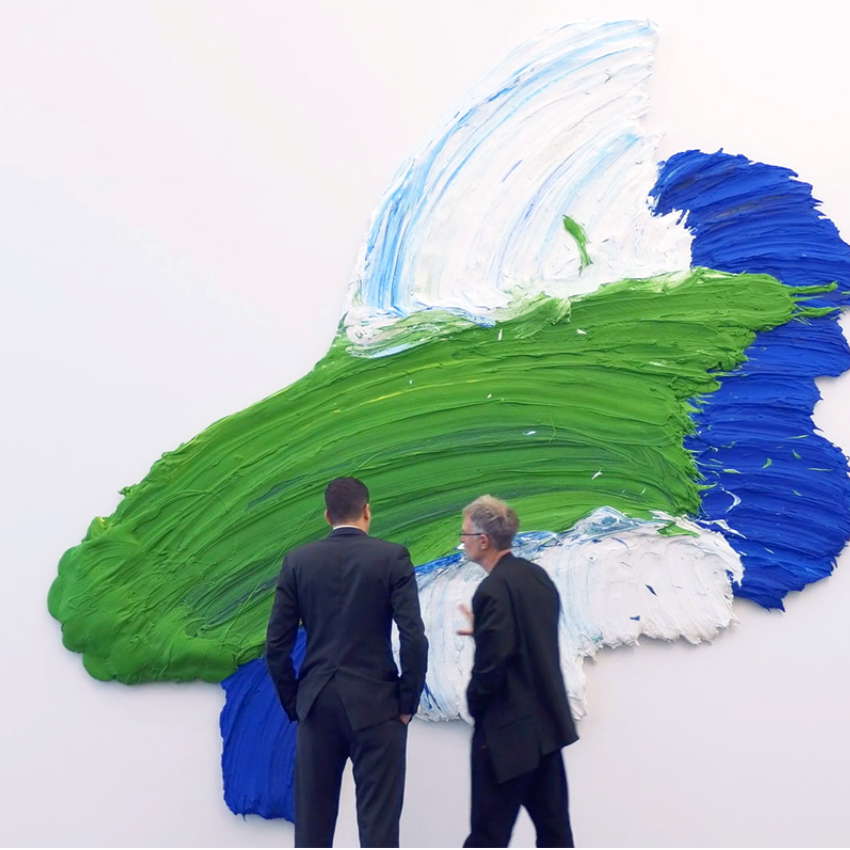01/09/2021
The brushstroke that makes eternal your art experience: Donald Martiny’s poetic
“
I prefer to create visceral experiences rather than intellectual explanations or narratives” D. Martiny
How many art exhibitions have you visited? I guess you have seen so many that you have lost count. However this time it’s different. Donald Martiny’s artworks have a kind of magical power: in each of them you can recognize a specific point in the author life. His paintings make eternal even the easiest life moments in an effort to celebrate every frame of the human existance. From the biggest events to the smallest ones. His creations are two-dimensional and three-dimensional: they are paintings and sculptures at the same time. In fact they emerge from the wall in which they are displayed. The artist was born in Schenectady (NY) in 1953 and currently works in Chapel Hill, North Carolina. His artworks are collected internationally and are shown widely. I’ve had the pleasure of interviewing him just some weeks before the opening of his last art exhibition in Venice (“PATHWAYS” – 10/09-10/10/2021 Scala Contarini del Bovolo San Marco). He has told us about his poetic and inspiration, his particular creative technique and last but not the least his relationship with some great art history masters.
Have a nice reading.
E.R. We can place your artworks between painting and sculpture. Your brushstrokes "frozen" your gestures in a particular moment of your life. Which intimate creative poetics underlies in your creations?D.M. For me, movement is life; stillness indicates the absence of life. I want to celebrate life. My paintings are living events, movement, time, and my own physicality, captured in paint.E.R. Your brushstrokes are self-supporting, without the need for a canvas. Why did you choose this particular effect?D.M. I create objects from gestures. My works are a dialectical challenge; an inquiry into metaphysical contradictions. Throughout art history, the traditional rectangular shaped canvas has been seen as a portal, a frame to a door or window that the viewer looks through to experience the art. I intend to move the experience in front of the window rather than behind the window. I want to involve the viewer as well as the space surrounding the work. That is why scale is very important to me. Large paintings invite the viewer inside, while the experience with small artworks the viewer is outside looking in. I have noticed that when people respond to artworks, they tend to approach and inspect them closely. I believe we do this because we want to participate in the work. We want to see the brushwork and see how the painting was made. During a recent exhibition of my work in Padua, Alessandro Deponti (my art dealer in Milan) and I visited the Scrovegni Chapel, a masterwork beautifully painted by Giotto in 1305. I was particularly struck by his Lamentation of Christ. In that panel Giotto invented a remarkable device to invite the viewer into the painting. The central foreground crouching figure is the first use of the rückenfigur or staffage. Much later, in 1808, Caspar David Friedrich revisited the idea in his famous painting, Der Mönch am Meer. With their back facing the viewer of the painting, the rückenfigur device looks into the work and invites the viewer to place themselves in the exact spot (substituting the rückenfigur with themselves) in the painting. This is a long explanation but it gets to the idea that I am trying to invite the viewer into the painting and also that I look to art history to find inspiration and ideas for my work. My art attempts to create powerful and moving experiences for the viewer. I prefer to create visceral experiences rather than intellectual explanations or narratives.

E.R. This decision has led you to a long research for finding the right pictorial material which can reproduce the fluidity of the brush and, at the same time, being hard to the right point to avoid breaks. Which kind of impasto do you use?D.M. I work with a specially made long-chain polymer. It makes an exceptionally viscus paint. Sometimes I grind my pigments using a sophisticated ultrasound machine that can create a very fine grain, enabeling me to pack the paint with the maximum amount of color. I paint on aluminum because aluminum doesn't expand or contract with changes in temperature or humidity. My paintings can be installed outdoors without any problems.E.R. Have some great masters of the art history influenced your path? If so, which ones?D.M. Absolutely! I would say the painters of the Venetian School, Titian, Tintoretto, Veronese, Bellini, with a particular emphasis on Tintoretto. I love the fact that according to Carlo Ridolfi his biographer, Tintoretto had a sign in his studio that read,"Colorito di Tiziano, disegno di Michelangelo.” (Ridolfi, Carol, Vita del Tintoretto, 1642, publication). I couldn't agree more. I often refer to Titian or Michelangelo, among many others, for ideas or inspiration. I have always found the innovators in art to be the most interesting. I look at the history of art in a very atemporal way and find ideas and inspiration from all of it. A few artists I particularly focus on are Greek artists like Apelles of Kos, Agesander, Athenodoros and Polydorus, to Ellsworth Kelly, Judy Pfaff, Frank Stella, Anselm Kiefer, and Bill Viola. I also often look to Caspar David Friedrich, Kazimir Malevich, Barnett Newman, and Willem de Kooning.

E.R. Can you describe us an artwork currently shown on the Artsail platform, where you are represented by ARTEA Gallery, which best reproduces your creative philosophy?D.M. Artsail is a wonderful platform that is so rewarding and interesting to explore. ArteA Gallery features a work of mine titled, Nushu, 2019 that is 91 x 112 cm. This painting made with seven red hues is an excellent example of how my work differs from most shaped paintings. Artists like Frank Stella, Elizabeth Murray, Ellsworth Kelly, George Sugarman, Mary Heilmann make their shaped paintings by building a form before painting it. My process is the opposite. I work on a large sheet of aluminum where I paint very freely, spontainiously, and gesturally, allowing for drips and pentimenti. Once the paint is dry enough, I cut away the negative spaces. The resulting freely painted gesture determines the form of the painting. I come from a serious study of the gestural abstract work of the modernists but lived through the ironic and somewhat cynical post-moderns. My work is not negative, ironic, or cynical at all. I am striving for authenticity and a poetry of deeply felt passion.

E.R. On the 10th of September your solo show will open in Venice. Its title is "PATHWAYS". Can you tell us something more about it?D.M. I believe the exhibition's title was conceived by Gianluca Ranzi, who generously and brilliantly curated the exhibition. He is a wonderful curator and writer who I had the great pleasure to meet at my first solo exhibition at ArteA Gallery in Milan. For me, "PATHWAYS" is a marvelous title as it touches on many different interpretations. Pathways are connectors; they take you from one place to another. They imply exploration and connections. Some are clear and well established, sometimes we make our own new pathway. The path could be the path of the brush and paint, the path of art history, the path of the artist, or the path of the viewer. I like to think of PATHWAYS as connection between the artwork, the viewer, and the artist. I was very excited to learn that my work will be shown in dialogue with the work of Tintoretto. How timely as he was working at a time the world was challenged by a plague just as we are now. I personally feel very connected to Tintoretto as he, perhaps more than any other artist of his time, worked in a very painterly, gestural, and immediate way. His pivotal painting, The miracle of the Slave or Miracle of St. Mark painted in 1548 (commissioned for the Scuola Grande di San Marco, now in the Gallerie dell'Accademia in Venice), is for me among the greatest works in the history of art. The remarkable invention of Saint Mark flying over the viewers into the painting is nothing short of miraculous. This invention forces the viewers to participate in the work rather than be casual observers of the work. Perhaps the exhibition's title, "PATHWAYS," is about forging a connection between Jacopo Robusti (called Tintoretto) and Donald Martiny. Born in Genoa, Milanese by adoption, Elisabetta Roncati decided to combine her university education in economics and management with her passion for culture with a goal: bringing people closer to the art market in a clear, easily understandable and professional way. Interested in all forms of artistic and cultural expressions, contemporary and otherwise, she has two great passions: textile art and African art. As an art consultant, she firmly believes that culture has the power to transcend the boundaries of individual nations, creating a global community of art lovers. In 2018 he founded the registered trademark Art Nomade Milan that she uses to speak about art and culture on the main social media platforms.
Born in Genoa, Milanese by adoption, Elisabetta Roncati decided to combine her university education in economics and management with her passion for culture with a goal: bringing people closer to the art market in a clear, easily understandable and professional way. Interested in all forms of artistic and cultural expressions, contemporary and otherwise, she has two great passions: textile art and African art. As an art consultant, she firmly believes that culture has the power to transcend the boundaries of individual nations, creating a global community of art lovers. In 2018 he founded the registered trademark Art Nomade Milan that she uses to speak about art and culture on the main social media platforms.







 This site uses anonymous technical cookies to ensure navigation and third-party cookies to monitor traffic and to offer additional services such as viewing videos or messaging systems. Without third-party cookies some pages may not work properly. Third-party cookies can track your activity and will only be installed by clicking on the "Accept all cookies" button. You can change your selection at any time by clicking on the "Cookie" link on each page at the bottom left. By clicking on one of the two buttons you declare that you have read the privacy policy and to accept the conditions.
This site uses anonymous technical cookies to ensure navigation and third-party cookies to monitor traffic and to offer additional services such as viewing videos or messaging systems. Without third-party cookies some pages may not work properly. Third-party cookies can track your activity and will only be installed by clicking on the "Accept all cookies" button. You can change your selection at any time by clicking on the "Cookie" link on each page at the bottom left. By clicking on one of the two buttons you declare that you have read the privacy policy and to accept the conditions.